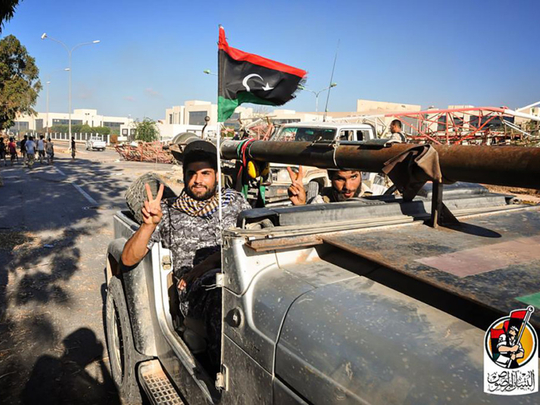
Sirte: Behind the front lines in the Libyan city of Sirte, ageing tanks crunch through the debris of battle to new positions and resting fighters drink sweetened coffee waiting for orders to advance.
Ahead, Daesh militants besieged in a single residential neighbourhood and targeted by US air strikes deploy mines, snipers and suicide bombers to defend their shrinking area.
After three-and-a-half months, the campaign to recapture the coastal city is in its final stages. “The fact that they’re using mines to such an extent shows they are weak now,” said Ahmad Alramali, a field commander. “This is their last chance.”
Daesh exploited Libya’s divisions to seize Sirte and rule it largely undisturbed for more than a year. But after a bloody campaign, brigades from the nearby city of Misrata stand poised to win back what became the militant group’s most important base outside the Middle East.
The loss of Sirte would compound Daesh setbacks suffered in Syria and Iraq. But the Sirte campaign has been halting, with onslaughts followed by long pauses as forces regroup and hospitals struggle to clear the wounded.
The brigades operate under command centres in Sirte and Misrata, aligned to a UN-backed government in Tripoli, but on the ground, formations are fluid, fighters are ill-equipped, and progress has been costly.
Esmail Shukri, head of military intelligence in Misrata, said brigades recovered copies of instructions for Daesh fighters to stage tactical withdrawals before launching car bombs.
“When our forces gather, Daesh fighters stage a retreat in order to send a car bomb. When our fighters advance on foot they have been an easy target,” he said. “Daesh have relied on mines, snipers and shelling, but they never use defensive lines to directly engage.”
On Sunday, 35 brigade fighters were killed as forces moved forward several hundred metres among emptied residential blocks in Sirte’s neighbourhood Number One, near the sea front, and towards the last Daesh holdouts in Neighbourhood Three.
On one street corner, fighters jumped out to fire automatic rifles above their heads alongside blasts from armed cars and anti-aircraft guns as they tried to dislodge a sniping position.
Just back from the front line a few blocks away, a group of fighters gathered casually near an abandoned car thought to be rigged with explosives. One rode up the street on a child’s bicycle, and another sat reading on top of a tank.
Air strikes, wheelbarrows
Fighters have welcomed US air strikes that began on August 1, saying they helped dislodge snipers, foil suicide attacks and prevent Daesh from moving. But some said the strikes came too late and were not intense enough.
One fighter said Daesh resorted to using wheelbarrows to transport equipment at night because their vehicles were being targeted from the air. Several barrows could be seen abandoned in Neighbourhood One.
Ebrahim Baitulmal, the head of Misrata’s military council, said some requests for strikes had not been granted, possibly due to concerns over civilians.
Almost all of Sirte’s estimated population of 90,000 fled the city after Daesh took over or as the battle began.
Any families that remain are those of Daesh fighters, Shukri said.
However, he said it was feared that up to 50 hostages were still in Sirte, including foreign nationals, a reason for caution in the battle’s final stages.
Officials and commanders say they do not know how many Daesh fighters retreated into neighbourhood Three, nor how many of the group’s senior commanders — who Shukri said were predominantly Tunisian, Egyptian and Sudanese — are among them.
But Shukri and Baitulmal said it was likely that a body found recently was that of Hassan Al Karami, a leading Libyan militant and preacher.
By most estimates, Daesh had 2,000-5,000 fighters before May in Sirte. Some are thought to have escaped near the start of the campaign and hundreds have been killed, though no figures are available. Not more than 15 have been arrested, none of them major figures, Baitulmal said.
On the side of the fighters from Misrata, a port city about 230km (145 miles) west of Sirte which bears the scars of a drawn-out battle in the revolution against late dictator Muammar Gaddafi five years ago, casualties have steadily mounted.
From an estimated force of 6,000, hospital officials say more than 500 men have been killed and more than 2,000 wounded.
Individual fighters insist they are fighting for Libya, not their city. They say they hope victory will help end the conflict and political strife that Daesh, which has struggled to win support elsewhere in Libya, exploited.
“We want to fight to defend our religion and our land,” said Abduwahab Abdelati, a 30-year-old commander who lost a cousin and a neighbour in a mine explosion on Sunday and had accompanied five wounded fighters to Misrata’s central hospital.
“These people are foreigners who came from outside and distorted our religion. But above all we want to free the people of Sirte from repression.”












